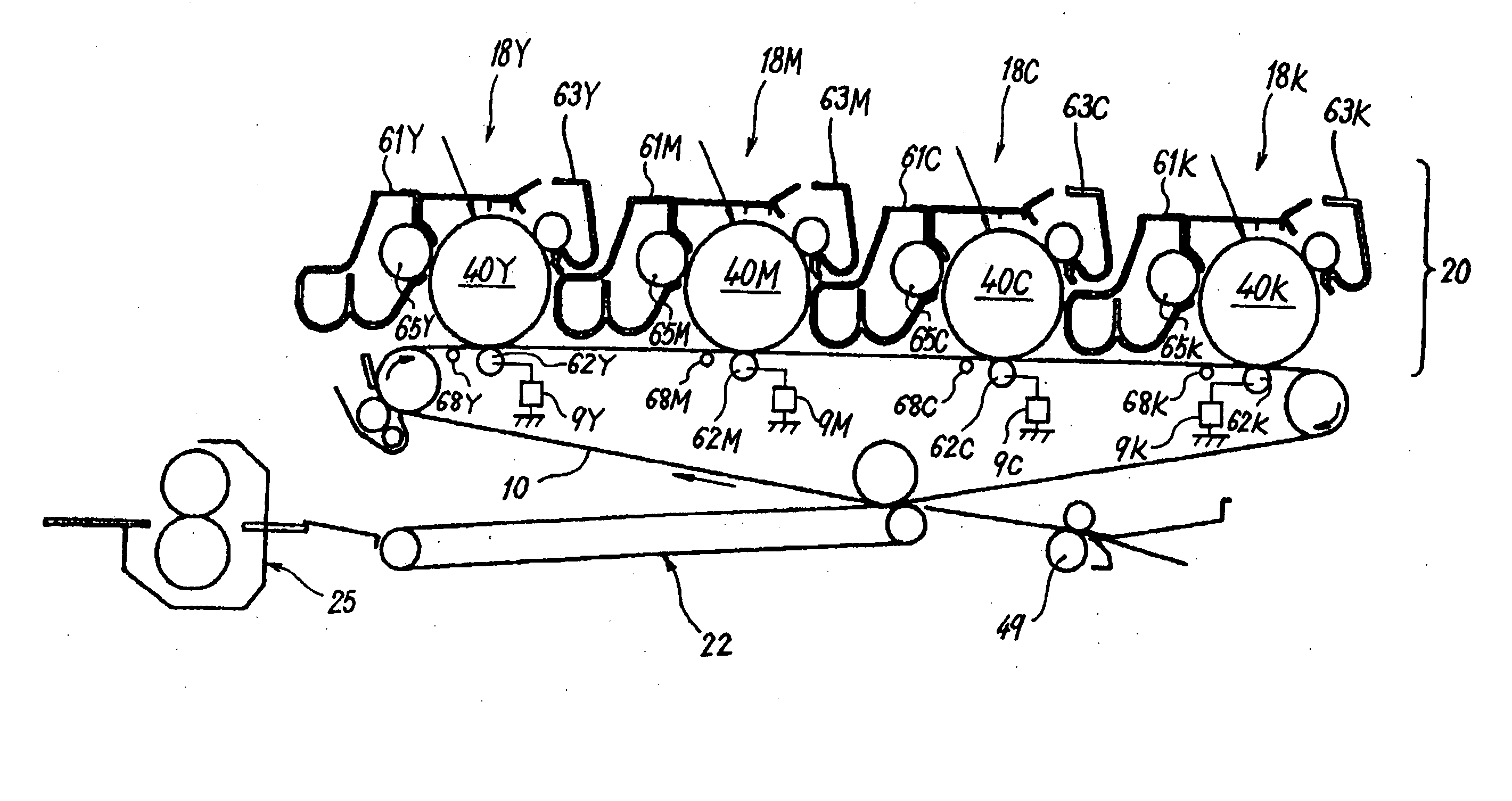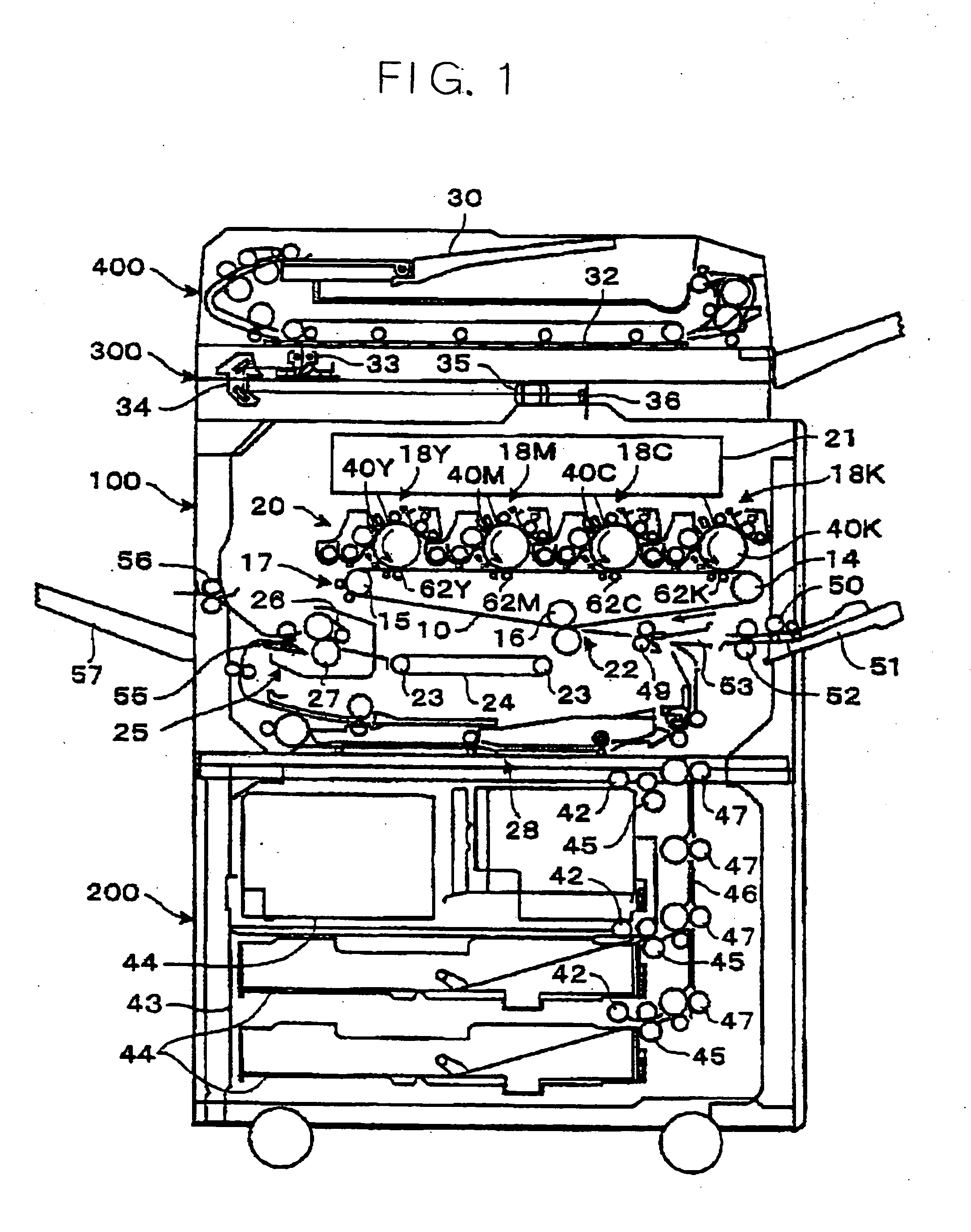Method for evaluating changes in resistance of electric resistance member and image forming apparatus using same
a technology of resistance value and resistance value, which is applied in the direction of resistance/resistance/impedence, electrographic process apparatus, instruments, etc., can solve the problems of insufficient electric charge supplied to the transfer belt, decrease in the resistance value insufficient resistance of the resistivity of the transfer belt, etc., to achieve good image quality and without transfer defects
- Summary
- Abstract
- Description
- Claims
- Application Information
AI Technical Summary
Benefits of technology
Problems solved by technology
Method used
Image
Examples
example 1
[0059] The relationship between the fluctuation characteristic of the surface resistivity in the continuous voltage application interval and the effect produced on the image in continuous copying and timed copying was studied.
[0060] First, intermediate transfer belts of seven types were fabricated and changes in the surface resistivity within a 2-100 seconds interval were studied by using the above-described method for measuring the surface resistivity. The results are shown in FIG. 5.
[0061] The intermediate transfer belts of seven types that were used for the test were fabricated by the following method. Belts Nos. 1-4, 6, 7 were monolayer endless belts composed of a polyimide resin. More specifically, they were fabricated by the following method. Carbon black was dispersed in a solution of a polyamic acid, the dispersion was poured into a cylindrical mold and heated to a temperature of 100-150° C., while rotating the cylindrical mold. As a result, the solvent was evaporated and ...
example 2
[0071] The control by the same voltage value and the control by the same current value were studied on the belts Nos. 1, 2, 4, 7 with a small absolute value Δρs of the amount of changes in the surface resistivity, which showed good results in the above-described tests. The voltage value and current value for the transfer bias were determined from the transfer ability observed when a belt with a standard surface resistance of 11 [Log(Ω / )] was used. As a result, when the belts Nos. 1, 2, 4, and 7 were constant voltage controlled by the same voltage value, the belts Nos. 1 and 7 were found to demonstrate insufficient or excessive transfer. On the other hand, when the belts Nos. 1, 2, 4, and 7 were constant current controlled by the same current value, good images were obtained for the belts Nos. 1, 2, 4, and 7.
[0072] The above-described results demonstrated that the constant current control allows for a wider tolerance with respect to resistance fluctuations than the constant voltage ...
example 3
[0073] Changes in the images caused by the position of transfer roller were studied by varying the position of the transfer roller.
[0074] First, the belts used in Example 1 were installed as the intermediate transfer belt 10 in the image forming apparatus in which the transfer roller 62 was provided in the position shown in FIG. 6, and one copy was made under the constant current control.
[0075] As a result, a transfer non-uniformity caused by abnormal charge was confirmed for all the belts other than the belt No. 2. In this case, the transfer roller 62 was far from the transfer nip portion, as follows from FIG. 6. This is apparently why an electric field in the gap close to the nip exit increased, causing an abnormal discharge in this region. Furthermore, in the belts other than the belt No. 2, the surface resistivity assumed a high value of 10 [Log(Ω / )] and the electric current could not flow easily in the circumferential direction of the belt. As a result, the applied voltage in...
PUM
 Login to View More
Login to View More Abstract
Description
Claims
Application Information
 Login to View More
Login to View More - R&D
- Intellectual Property
- Life Sciences
- Materials
- Tech Scout
- Unparalleled Data Quality
- Higher Quality Content
- 60% Fewer Hallucinations
Browse by: Latest US Patents, China's latest patents, Technical Efficacy Thesaurus, Application Domain, Technology Topic, Popular Technical Reports.
© 2025 PatSnap. All rights reserved.Legal|Privacy policy|Modern Slavery Act Transparency Statement|Sitemap|About US| Contact US: help@patsnap.com



